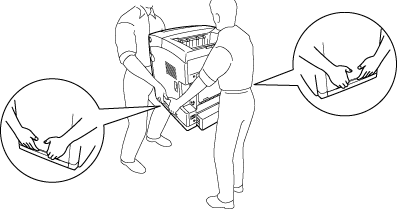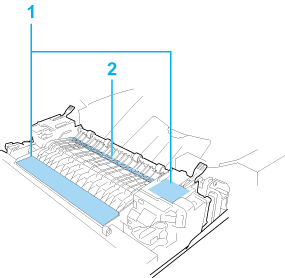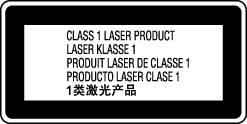 |
 Warnings, Cautions, and Notes Warnings, Cautions, and Notes
 Safety precautions Safety precautions
 Important Safety Instructions Important Safety Instructions
 Safety Information Safety Information
 Power On/Off Cautions Power On/Off Cautions
Warnings, Cautions, and Notes
 |
Warnings |
 |
|
must be followed carefully to avoid bodily injury.
|
|
 |
Cautions |
 |
|
must be observed to avoid damage to your equipment.
|
|
 |
Notes |
 |
|
contain important information and useful tips on the operation of your printer.
|
|
Be sure to follow the precautions carefully to ensure safe, efficient operation:
-
Because the printer weighs approximately 31 kg (68.2 lb) with consumable products installed, one person should not lift or carry it. Two people should carry the printer, lifting it by the correct positions as shown below.

-
Be careful not to touch the fuser, which is marked CAUTION HIGH TEMPERATURE, or the surrounding areas. If the printer has been in use, the fuser and the surrounding areas may be very hot. If you must touch one of these areas, wait 30 minutes to allow the heat to subside before doing so.

-
If toner is spilled, use a broom and dustpan or a damp cloth with soap and water to clean it up. Because the fine particles can cause a fire or explosion if they come into contact with a spark, do not use a vacuum cleaner.
-
When removing the imaging cartridge, do not expose it to sunlight at all and avoid exposing it to room light for more than five minutes. The imaging cartridge contains a light-sensitive drum that is purple. Exposure to light can damage the drum, causing dark or light areas to appear on the printed page and reducing the service life of the drum. If you need to keep the imaging cartridge out of the printer for long periods, cover it with an opaque cloth.
-
Be careful not to scratch the surface of the drum. When you remove the imaging cartridge from the printer, always place it on a clean, smooth surface. Avoid touching the drum, since oil from your skin can permanently damage its surface and affect print quality.
-
To get the best print quality, do not store the imaging cartridge in an area subject to direct sunlight, dust, salty air, or corrosive gases (such as ammonia). Avoid locations subject to extreme or rapid changes in temperature or humidity.
Important Safety Instructions
Read all of the following instructions before operating your printer:
When choosing a place and power source for the printer
-
Slots and openings in the cabinet and the back or bottom are provided for ventilation. Do not block or cover them. Do not put the printer on a bed, sofa, rug, or other similar surface or in a built-in installation unless proper ventilation is provided.
-
Connect your printer to an electrical outlet that meets the power requirements of this printer. Your printer’s power requirements are indicated on a label attached to the printer. If you are not sure of the power supply specifications in your area, contact your local power company or consult your dealer.
|
A.
|
When the power cord or plug is damaged or frayed.
|
|
B.
|
If liquid has been spilled into it.
|
|
C.
|
If it has been exposed to rain or water.
|
|
D.
|
If it does not operate normally when the operating instructions are followed. Adjust only those controls that are covered by the operating instructions since improper adjustment of other controls may result in damage and will often require extensive work by a qualified technician to restore the product to normal operation.
|
|
E.
|
If it has been dropped or the cabinet has been damaged.
|
|
F.
|
If it exhibits a distinct change in performance, indicating a need for service.
|
 |
Caution: |
 |
|
Be sure the AC power cord meets the relevant local safety standards.
Use only the power cord that comes with this product. Use of the another cord may result in fire or electric shock.
This product’s power cord is for use with this product only. Use with other equipment may result in fire or electric shock.
|
|
 |
Warning: |
 |
|
The performance of procedures and adjustments other than those specified in the printer’s documentation may result in hazardous radiation exposure.
Your printer is a Class 1 laser product as defined in the IEC60825 specifications. The label shown is attached to the back of the printer in countries where required.
|
|

|
Max. Average Radiation Power:
|
5 mW at laser aperture
|
|
Wavelength:
|
770 to 800 nm
|
This is a Class III b Laser Diode Assembly that has an invisible laser beam. The printer head unit is NOT A SERVICE ITEM, therefore, the printer head unit should not be opened under any circumstances. An additional laser warning label is affixed to the inside of the printer.
Ozone gas is generated by laser printers as a by-product of the printing process. Ozone is produced only when the printer is printing.
The recommended exposure limit for ozone is 0.1 parts per million (ppm) expressed as an average time-weighted concentration over an eight (8) hour period.
The Epson laser printer generates less than 0.1 ppm for eight (8) hours of continuous printing.
To minimize the risk of exposure to ozone, you should avoid the following conditions:
The printer should be located so that the exhaust gases and heat generated are:
Do not turn off the printer:
|  |







 Warnings, Cautions, and Notes
Warnings, Cautions, and Notes


 Top
Top